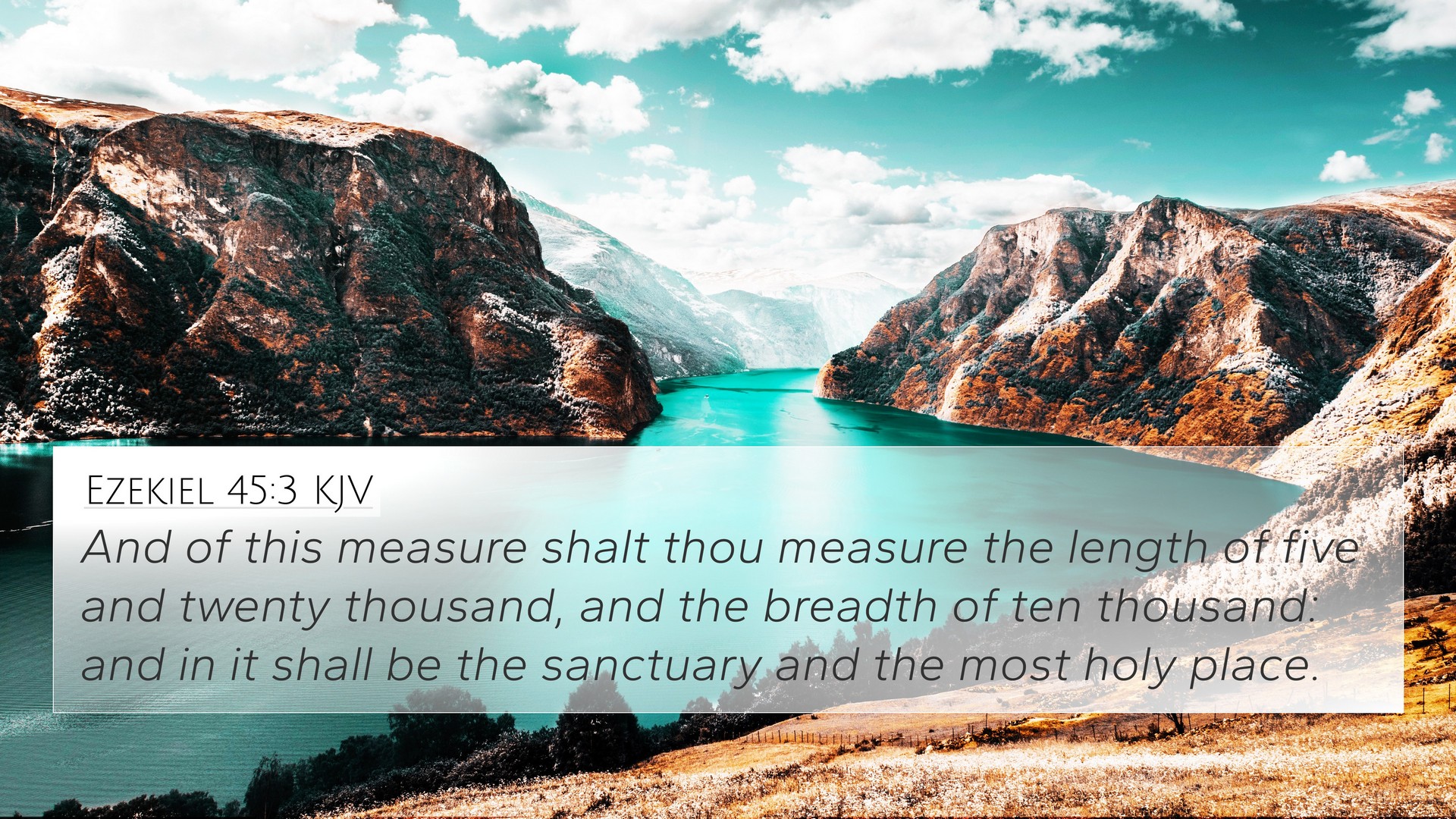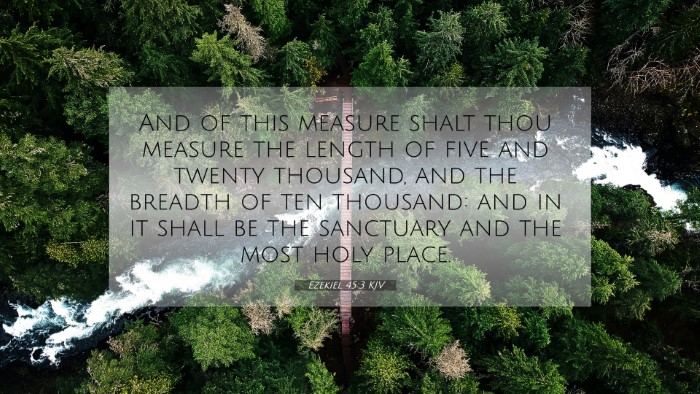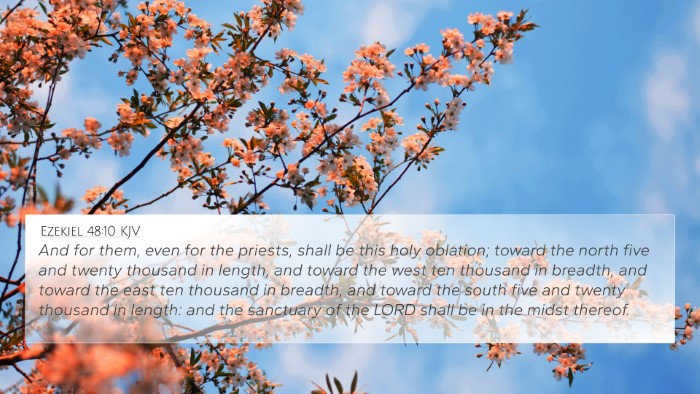Ezekiel 45:3 - Meaning and Interpretation
Ezekiel 45:3 reads, "And of this measure thou shalt measure the length of five and twenty thousand reeds, and the breadth of ten thousand: this shall be the holy place for the priests, the ministers of the sanctuary, which shall come near to minister unto the Lord: and the place shall be for their houses, and an holy place for the sanctuary."
This verse describes the measurements of the sacred area designated for the priests and the sanctuary, underscoring the importance of precision in the divine instructions given to Ezekiel regarding the future temple. Below, we will explore its meaning by consolidating insights from various public domain commentaries.
Summary of Insights
-
Matthew Henry's Commentary:
Henry emphasizes the significance of separating a portion of land specifically for the priests. This not only highlights the holiness of the area but also ensures that the priests have a designated place for their ministry, allowing them to fulfill their roles without distraction from secular demands. The measurements indicated reflect God's desire for order and sanctity in worship.
-
Albert Barnes' Notes:
Barnes elaborates on the detailed specifications for the sacred space, linking it to God's covenant with His people. He points out that this allocation for the priests signifies God's provision and care for those who serve in His temple. It is a tangible representation of their responsibilities and the reverence due to the Lord's presence.
-
Adam Clarke's Commentary:
Clarke discusses the symbolic dimensions of the measurements. He compares them to similar dimensions found in the earlier books of the Bible, linking Ezekiel’s vision to the requirements of the tabernacle and the first temple. This connection underlines the continuity of God's instructions throughout biblical history.
Thematic Connections
Ezekiel 45:3 is not isolated but rather resonates with multiple scriptures that speak to divine measurement and the sanctification of space for worship. Below are some cross-references that provide further understanding:
- Exodus 25:9 - "According to all that I show thee, after the pattern of the tabernacle, and the pattern of all the instruments thereof, even so shall ye make it." This verse relates to God's detailed instructions for building the tabernacle.
- 1 Chronicles 28:12 - "And the pattern of all that he had by the Spirit, of the courts of the house of the Lord, and of all the chambers round about, of the treasures of the house of God, and of the treasures of the dedicated things." Here, the emphasis is on conforming to God's design for worship spaces.
- Hebrews 9:24 - "For Christ is not entered into the holy places made with hands, which are the figures of the true; but into heaven itself, now to appear in the presence of God for us." This articulates the transition from a physical temple to a spiritual one, signifying the ultimate fulfillment of God's presence.
- Revelation 21:16 - "And the city lieth four-square, and the length is as large as the breadth: and he measured the city with the reed, twelve thousand furlongs." This relates aesthetics and symmetry in divine architecture, similar to Ezekiel's measurements.
- Leviticus 21:8 - "Thou shalt sanctify him therefore; for he offereth the bread of thy God: he shall be holy unto thee: for I the Lord, which sanctify you, am holy." This underscores the sanctification required for those serving in the temple.
- Isaiah 54:17 - "No weapon that is formed against thee shall prosper; and every tongue that shall rise against thee in judgment thou shalt condemn. This is the heritage of the servants of the Lord, and their righteousness is of me, saith the Lord." This speaks to the protection and sanctity over those engaged in holy service.
- Matthew 5:14 - "Ye are the light of the world. A city that is set on a hill cannot be hid." Symbolically connects to the idea of light and holiness referenced in Ezekiel's vision of the holy space.
Understanding the Priestly Role
The designation of space specifically for priests points to the sacredness of their service. The areas around the temple were not just functional but also integral to the community's relationship with God, highlighting themes of holiness and consecration.
Exploring Cross-References
Understanding Ezekiel 45:3 within the wider narrative of the Bible involves recognizing the interconnected themes of sacred space and divine authority. Here are methods and resources to explore these themes further:
- How to use Bible cross-references: By looking up verses that relate to temple worship and the dimensions given, readers can see how the narrative connects across scripture.
- Tools for Bible cross-referencing: Utilize resources like concordances or online databases that compile cross-references to identify connections.
- Bible reference resources: Study guides that focus on thematic explorations of scripture can enhance understanding of how God’s sanctuary is portrayed through the ages.
- Cross-reference Bible study: Grouping biblical text by similar themes can illuminate underlying truths about God's design for worship.
Conclusion
Ezekiel 45:3 serves as a powerful reminder of God's specifications for holiness and order in worship. Understanding its implications through public domain commentaries sheds light on the divine intentions behind the measurements presented. The verse is deeply rooted in a broader inter-Biblical dialogue that emphasizes the sacredness of the priestly role and the significance of set-apart spaces for worship. By engaging with related scriptures and using various cross-referencing tools, believers can deepen their understanding of this verse and its implications for faith and practice today.



